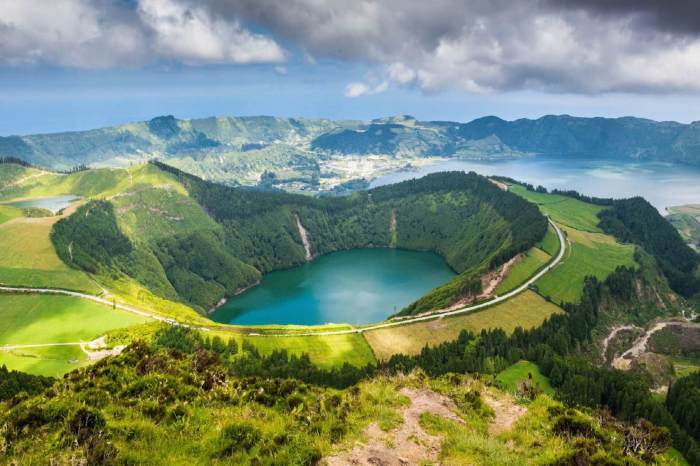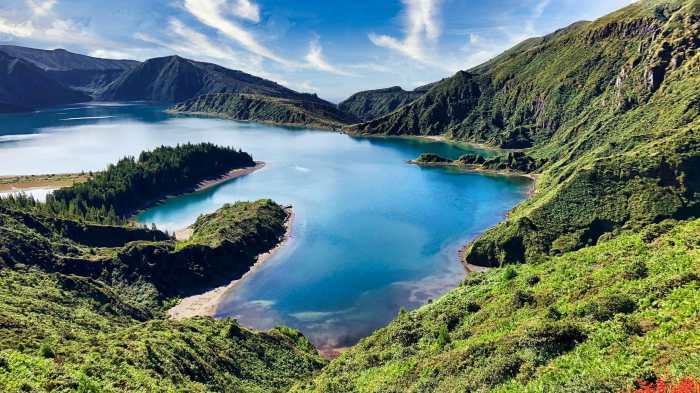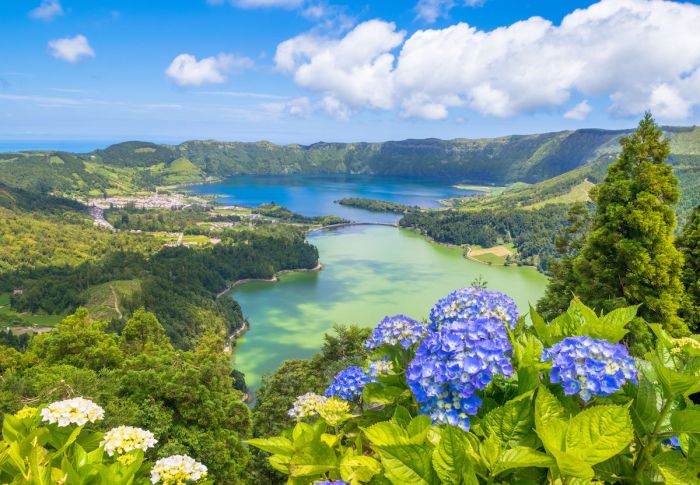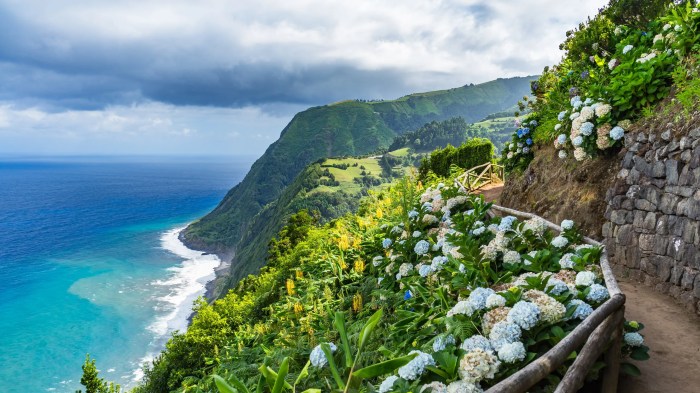Nestled amidst the vast Atlantic Ocean, the Azores archipelago beckons with its breathtaking landscapes, rich history, and vibrant culture. From its volcanic origins to its modern-day allure, the Azores offer an unforgettable journey that will captivate the hearts of travelers.
Unveiling the Azores’ tapestry, this comprehensive guide explores the archipelago’s unique geography, fascinating history, thriving tourism industry, and abundant natural wonders. Immerse yourself in the vibrant traditions and customs that have shaped the Azores’ identity, and discover the challenges and opportunities that define its present and future.
Geography of the Azores

The Azores archipelago is a group of nine volcanic islands located in the North Atlantic Ocean, about 1,500 kilometers (930 miles) west of mainland Portugal. The islands are divided into three groups: the Eastern Group, the Central Group, and the Western Group. The Eastern Group consists of the islands of Santa Maria and São Miguel. The Central Group consists of the islands of Terceira, Graciosa, São Jorge, Pico, and Faial. The Western Group consists of the islands of Flores and Corvo.
The Azores islands are all of volcanic origin, and their topography is characterized by steep cliffs, volcanic cones, and craters. The climate of the Azores is subtropical, with mild temperatures year-round. The average temperature in January is 14°C (57°F), and the average temperature in July is 24°C (75°F). The islands receive an average of 1,000 millimeters (39 inches) of rainfall per year.
The Azores islands are rich in natural resources, including fish, timber, and geothermal energy. The islands are also home to a variety of plant and animal life, including many endemic species.
Topography
The Azores islands are all of volcanic origin, and their topography is characterized by steep cliffs, volcanic cones, and craters. The highest point in the Azores is Mount Pico, which is located on the island of Pico. Mount Pico is a stratovolcano, and it is the highest mountain in Portugal.
Climate
The climate of the Azores is subtropical, with mild temperatures year-round. The average temperature in January is 14°C (57°F), and the average temperature in July is 24°C (75°F). The islands receive an average of 1,000 millimeters (39 inches) of rainfall per year.
Natural Resources
The Azores islands are rich in natural resources, including fish, timber, and geothermal energy. The islands are also home to a variety of plant and animal life, including many endemic species.
History and Culture of the Azores

The Azores, a group of islands in the North Atlantic Ocean, boasts a rich and diverse history and culture. From its initial discovery to its present-day status as an autonomous region of Portugal, the Azores has been influenced by various cultures, including Portuguese, Spanish, and American.
Portuguese Influence
The Portuguese were the first to discover the Azores in the 15th century, and their influence is evident throughout the islands. The Portuguese language is the official language of the Azores, and the region’s architecture, cuisine, and traditions bear a strong Portuguese imprint. The capital city of Ponta Delgada, with its cobblestone streets and historic churches, is a testament to the enduring Portuguese heritage of the Azores.
Spanish Influence
The Azores’ proximity to Spain has also influenced its culture. Spanish is widely spoken in the region, and many traditional Azorean dishes have Spanish origins. The islands’ cuisine features a blend of Portuguese and Spanish flavors, with dishes such as cozido das furnas (a meat and vegetable stew cooked in volcanic hot springs) and lapas grelhadas (grilled limpets) being popular.
The Azores archipelago is a stunning collection of islands located in the Atlantic Ocean, offering breathtaking landscapes and a rich history. For a taste of a different kind of historical adventure, explore the Alamo in San Antonio , Texas, where you can immerse yourself in the iconic battle for Texan independence.
Back in the Azores, discover the vibrant culture, delectable cuisine, and unparalleled natural beauty that make these islands a true gem.
American Influence
The Azores’ strategic location in the Atlantic Ocean has also led to American influence. During World War II, the United States established military bases on the islands, which played a crucial role in the Allied victory. The American presence left a lasting impact on the Azores, with English being widely spoken and American cultural influences visible in the region’s music, fashion, and lifestyle.
Unique Traditions and Customs
Despite these external influences, the Azores has maintained its unique traditions and customs. The islands are known for their colorful festivals, such as the Festa do Senhor Santo Cristo dos Milagres (Festival of the Holy Christ of Miracles), which attracts thousands of pilgrims each year. The Azores is also home to a vibrant music scene, with traditional genres such as chamarrita and modinhas being popular.
Tourism and Economy of the Azores

The Azores archipelago boasts a thriving tourism industry, captivating visitors with its breathtaking natural landscapes, rich cultural heritage, and diverse outdoor activities. Agriculture, fishing, and tourism serve as the cornerstones of the region’s economy, contributing significantly to its growth and prosperity.
Tourism, Azores
The Azores’ tourism sector has witnessed a steady rise in popularity, attracting nature enthusiasts, adventure seekers, and cultural buffs alike. The archipelago’s stunning volcanic landscapes, lush greenery, and crystal-clear waters offer an array of activities, including hiking, whale watching, scuba diving, and paragliding.
- Whale Watching: The Azores is renowned for its exceptional whale-watching opportunities, with over 20 species of whales and dolphins inhabiting its waters.
- Hiking: The archipelago’s diverse terrain offers a range of hiking trails, from gentle coastal walks to challenging mountain ascents, showcasing the region’s volcanic origins and breathtaking scenery.
- Scuba Diving: The Azores’ pristine waters and abundant marine life make it a paradise for scuba divers, offering visibility up to 30 meters and encounters with a wide variety of marine species.
- Paragliding: The island of São Miguel provides excellent conditions for paragliding, with its soaring cliffs and panoramic views of the Atlantic Ocean.
Economic Sectors
Agriculture, fishing, and tourism form the backbone of the Azores’ economy. Agriculture remains a vital sector, with dairy farming, cattle ranching, and pineapple cultivation playing significant roles. Fishing has a long tradition in the region, with tuna, swordfish, and other species contributing to the local economy.
- Agriculture: The Azores’ fertile volcanic soils and temperate climate support a thriving agricultural sector. Dairy products, such as cheese and butter, are major exports, while pineapples are a popular cash crop.
- Fishing: Fishing has been a cornerstone of the Azores’ economy for centuries. Tuna, swordfish, and other species are caught in the surrounding waters, providing a valuable source of income.
- Tourism: The growth of tourism in recent years has become a major driver of economic growth in the Azores. The industry has created numerous jobs and boosted local businesses.
Challenges and Opportunities
The Azores’ economy faces challenges related to its remote location, limited infrastructure, and reliance on a few key sectors. However, the region also possesses opportunities for diversification and sustainable growth.
- Challenges: The Azores’ remote location can make it difficult to attract investment and skilled workers. Additionally, the region’s reliance on tourism and agriculture can make it vulnerable to economic fluctuations.
- Opportunities: The Azores has the potential to diversify its economy by investing in renewable energy, technology, and other emerging industries. The region’s unique natural environment also presents opportunities for ecotourism and sustainable development.
Nature and Wildlife of the Azores
The Azores archipelago is renowned for its breathtaking natural beauty, boasting a rich and diverse flora and fauna that has evolved in isolation over millions of years. From lush forests to rugged coastlines, the islands provide a sanctuary for an array of species, both on land and in the surrounding waters.
Flora of the Azores
The Azores’ unique geographic location and volcanic origins have fostered the development of a distinctive plant life. The islands are home to over 600 native plant species, many of which are endemic to the archipelago. Among the most iconic flora is the Azorean laurel forest, a temperate rainforest that once covered much of the islands but is now largely confined to the higher elevations. These forests are characterized by dense vegetation, towering trees, and an abundance of mosses, ferns, and lichens.
In addition to the laurel forests, the Azores are also home to a variety of other plant communities, including coastal heathlands, grasslands, and bogs. These habitats support a diverse range of plant species, including wildflowers, shrubs, and trees.
The Azores, a stunning archipelago in the Atlantic Ocean, offers a blissful beach holiday experience. To make the most of your trip, consider consulting a beach holiday packing list. This comprehensive guide will ensure you have everything you need for a relaxing and unforgettable stay in the Azores, where pristine beaches, breathtaking landscapes, and vibrant culture await.
Fauna of the Azores
The Azores’ diverse habitats provide a home for a wide range of animal species. The islands are particularly renowned for their birdlife, with over 400 species recorded, including many migratory birds that use the archipelago as a resting and feeding ground. Some of the most notable bird species include the Azores bullfinch, the common buzzard, and the Cory’s shearwater.
The Azores, an archipelago in the Atlantic Ocean, boasts a temperate climate and stunning landscapes. Time is a crucial factor when planning your trip, and the Azores observe Abu Dhabi time , which is 2 hours ahead of Coordinated Universal Time (UTC).
This time difference allows for ample daylight hours to explore the islands’ natural wonders, such as volcanic craters, lush forests, and crystal-clear waters.
The Azores are also home to a variety of marine life. The surrounding waters are rich in fish, including tuna, marlin, and swordfish. The islands are also home to a number of marine mammals, such as whales, dolphins, and seals.
Importance of the Azores as a Habitat for Migratory Birds and Marine Life
The Azores play a vital role as a habitat for migratory birds and marine life. The islands are located along major migratory routes, providing a resting and feeding ground for birds traveling between Europe and Africa. The Azores are also an important breeding ground for many marine species, including seabirds and sea turtles.
Conservation Efforts in the Azores
The Azores government has implemented a number of conservation measures to protect the archipelago’s natural heritage. These measures include the establishment of protected areas, such as the Azores National Park, and the implementation of sustainable fishing practices. The government is also working to raise awareness of the importance of conservation and to promote responsible tourism practices.
Transportation and Accessibility
The Azores offers various transportation options to reach and explore the archipelago. Air, sea, and land transportation provide distinct advantages and challenges.
Air travel is the primary means of reaching the Azores from mainland Portugal and international destinations. The main airports are located on the islands of São Miguel, Terceira, and Faial, providing connections to major cities worldwide. The advantages of air travel include speed, convenience, and direct access to the islands. However, it can be more expensive and subject to weather conditions.
Sea transportation is an alternative option, with ferries connecting the islands to each other and to mainland Portugal. Ferries offer a slower but more scenic journey, allowing passengers to enjoy the stunning coastal views. They are also typically more affordable than air travel. However, ferry schedules can be limited, especially during off-season, and weather conditions can impact their reliability.
Within the Azores, land transportation options include buses, taxis, and rental cars. Buses provide a convenient and affordable way to travel between major towns and cities on each island. Taxis are readily available in urban areas but can be more expensive. Rental cars offer the most flexibility and independence, allowing travelers to explore the islands at their own pace. However, driving conditions can be challenging due to narrow roads and mountainous terrain.
Improving accessibility to the Azores is an ongoing challenge. The remote location of the archipelago can limit connectivity, and weather conditions can disrupt transportation services. However, efforts are being made to enhance transportation infrastructure, such as expanding airport capacity and upgrading ferry terminals. Additionally, the development of sustainable transportation options, such as electric vehicles and inter-island ferries, is being explored to reduce the environmental impact of tourism.
Final Summary

As we bid farewell to the Azores, its enchanting beauty and captivating spirit will linger in our memories. This extraordinary archipelago stands as a testament to the power of nature, the resilience of culture, and the indomitable spirit of its people. Whether you seek adventure, tranquility, or a glimpse into a world untouched by time, the Azores await with open arms, promising an unforgettable experience.
Helpful Answers
How do I get to the Azores?
The Azores are accessible by air and sea. Ponta Delgada Airport (PDL) is the main international airport, with direct flights from major cities in Europe and North America.
What is the best time to visit the Azores?
The Azores enjoy a mild climate year-round, but the best time to visit is during the spring (April-May) or fall (September-October) when the weather is pleasant and there are fewer crowds.
What are the must-see attractions in the Azores?
The Azores offer a diverse range of attractions, including stunning volcanic landscapes, lush forests, picturesque lakes, and charming towns. Must-see destinations include Furnas Lake, Sete Cidades, and the historic city of Angra do Heroísmo.